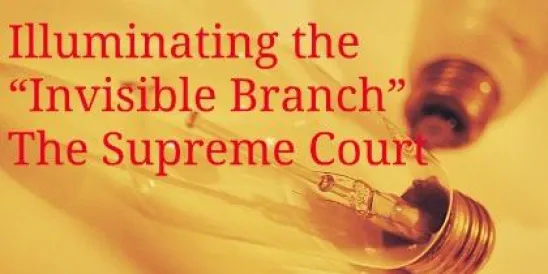While Congress’ deliberations over policy dominate the news, the Supreme Court often flies under the radar of the American people, unless there is a major case before it. Many Americans are not well-versed in the Supreme Court’s dealings; in fact, a Pew Research Center political knowledge survey found that in July 2010 only 28% of Americans polled could correctly identify John Roberts as the Chief Justice of the Court. As much of the health policy world’s attention is focused on the Supreme Court due to the Affordable Care Act case (Department of Health and Human Services, et al. v. Florida, et al.), below is a refresher on Supreme Court procedure and why there will be months of silence from the Court between the oral arguments and the announcement of the Court’s decision.
First, a few Supreme Court basics. The Supreme Court’s term begins on the first Monday in October and lasts for a year. The Court is typically in recess from late June or early July until the end of the term in October. The current term began on Monday, October 3, 2011, and will be wrapping up business for this term over the next two months. The next term will begin on Monday, October 1, 2012.
Each week when the Court is in session, the Justices hold a conference. Only the Justices are allowed in the room, and as a testament to the collegiality of the Court, each conference begins with each Justice shaking hands with every other Justice. During conferences, the Justices review petitions for certiorari or, in other words, decide which cases the Court will hear. The Justices then review the cases heard previously that week. Each Justice, beginning with the Chief Justice and going in order of seniority (who has been on the court the longest), is given time to state his or her views and raise any questions without interruption. Each Justice, in seniority order, then casts a preliminary vote on the case. In the case of the health reform arguments, which were heard March 26-28, the Justices met in conference to discuss the case and cast their votes on Friday, March 30.
So, if the votes have been cast and an outcome decided, why has there been no announcement of a decision yet? What has been going on since March 30?
After the votes are cast, the Court must then produce documents that state the Court’s reasoning for deciding a certain way. If the Chief Justice is in the majority (generally an opinion five or more Justices join), he or she assigns who will write the opinion. If the Chief Justice dissents from the majority opinion, the senior-most associate Justice in the majority assigns the opinion. The Chief Justice or most senior Justice may choose to write the opinion him or her self. Likewise, the most senior Justice in the minority assigns who will write the dissenting opinion. Dissenting opinions carry no legal weight or precedent, but might lay groundwork for future cases. Additionally, any Justice may write a concurring opinion, and anyone can write a separate dissenting opinion should they agree with the ruling but for a different rationale. In the case of a tie vote, which might happen if there is a vacant seat or if a Justice recuses themselves from the case, the decision of the lower court stands. In this situation, the case is not considered to be binding precedent.
Once the opinions have been drafted, they are circulated to all the other Justices for comments and recommended changes. If a Justice in the majority agrees with the outcome expressed but disagrees with the argument in the drafted opinion, they may write their own concurring opinion or, at anytime before the Court’s opinion is handed down, they may switch their vote. In some controversial cases, the outcome of the case has actually reversed from what the original outcome would have been, due to Justices flipping their vote. Then once the draft has been revised, the opinion is signed by the author. Other Justices who are in agreement then “sign on” to the opinion, and the verdict is subsequently made public.
In regard to the timing of decision announcements, there are no rules other than it must be released by the last day of term (before the Court goes into recess in June or July). Unanimous or less contentious decisions generally take less time than cases on more controversial subjects. Given the weight and attention given to the health reform cases, a decision is not expected until late in the term, with most people predicting an announcement coming June 21st, 25th or 28th.



 />i
/>i
